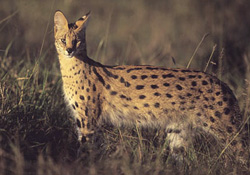|
|


Conservation research studies are most important for the future for the Serval cat. Serval cats are difficult to study in the wild due to their elusive nature. Servals are nocturnal felines, living in tall grasses where little to no tracks can be found, so it is very hard to study these felines in their native habitat. Most of the lesser-cat species have never been studied in their native habitat, which poses a risk of them becoming extinct before we know it. Servals live in the tall grass of the African savanna in areas with an abundance of water.
An area of interest may lie in the Northwest region of Africa, which has been isolated for over 6,000 years. A Serval's range can extend into the alpine areas of Ethiopia and Kenya.
Unlike most wild cats, Servals are not endangered (yet), and CITES has them on Appendix II. They are not protected over most of their range, even though Serval hunting is now prohibited in 9 of the 41 countries within that range. We assume that a viable, healthy population exits, but we need more studies to be conducted. Without these studies, the Serval may slip into extinction; gone forever from this planet.
Lately, conservation programs are beginning to focus more attention on these smaller felines thanks to teams of conservationists.
|
